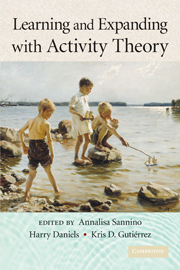Book contents
- Frontmatter
- Contents
- Contributors
- Editors' introduction
- 1 Activity Theory Between Historical Engagement and Future-Making Practice
- PART ONE UNITS OF ANALYSIS
- PART TWO MEDIATION AND DISCOURSE
- PART THREE EXPANSIVE LEARNING AND DEVELOPMENT
- PART FOUR SUBJECTIVITY, AGENCY, AND COMMUNITY
- PART FIVE INTERVENTIONS
- 16 Who Is Acting in an Activity System?
- 17 Past Experiences and Recent Challenges in Participatory Design Research
- 18 Clinic of Activity: The Dialogue as Instrument
- 19 The Future of Activity Theory: A Rough Draft
- Bibliography
- Author Index
- Subject Index
18 - Clinic of Activity: The Dialogue as Instrument
Published online by Cambridge University Press: 05 June 2012
- Frontmatter
- Contents
- Contributors
- Editors' introduction
- 1 Activity Theory Between Historical Engagement and Future-Making Practice
- PART ONE UNITS OF ANALYSIS
- PART TWO MEDIATION AND DISCOURSE
- PART THREE EXPANSIVE LEARNING AND DEVELOPMENT
- PART FOUR SUBJECTIVITY, AGENCY, AND COMMUNITY
- PART FIVE INTERVENTIONS
- 16 Who Is Acting in an Activity System?
- 17 Past Experiences and Recent Challenges in Participatory Design Research
- 18 Clinic of Activity: The Dialogue as Instrument
- 19 The Future of Activity Theory: A Rough Draft
- Bibliography
- Author Index
- Subject Index
Summary
This chapter highlights three important dimensions of Yrjö Engeström's work. It then examines some objections that have been recently addressed to him. Finally, the chapter presents an original French approach that is not sufficiently well known internationally, although some publications in languages other than French have recently appeared (Béguin & Clot, 2004; Clot, Fernandez, & Carles, 2002; Clot & Scheller, 2006). Engeström has, in his own way, allowed the “French-speaking school” of analysis of activity to come into contact and enter into discussions with the Anglo-Saxon world. In France this discussion was recently relaunched with the symposium “Situated Action and Activity Theory” (ARTCO) in Lyon, where researchers from different countries met to debate their conceptions of “action,” “activity,” and “collective” (Clot, 2005a; Engeström, 2006b).
TRANSFORMING FOR UNDERSTANDING
The position given by Engeström to transformative action in the workplace brings him very close to the French-speaking school of analysis of work and activity. Whereas international ergonomics focused on the engineering of task and artifacts, French-speaking ergonomics was organized around activity and health with the intention of preserving and developing the operators' power to act in the workplace. Vygotsky's work is indeed inseparable from this perspective on action. When Vygotsky analyzed the crisis of psychology, he pointed to practice as a means to overcome the crisis. He even presented practice as a real alternative to the blind empiricism that can paralyze psychology (Vygotsky, 1997a), as is still the case today.
- Type
- Chapter
- Information
- Learning and Expanding with Activity Theory , pp. 286 - 302Publisher: Cambridge University PressPrint publication year: 2009
- 46
- Cited by

